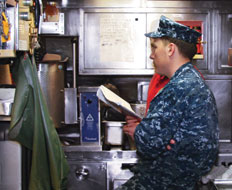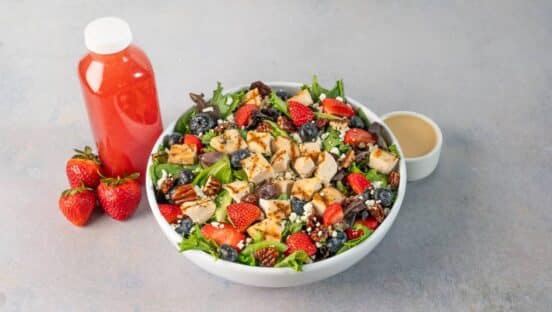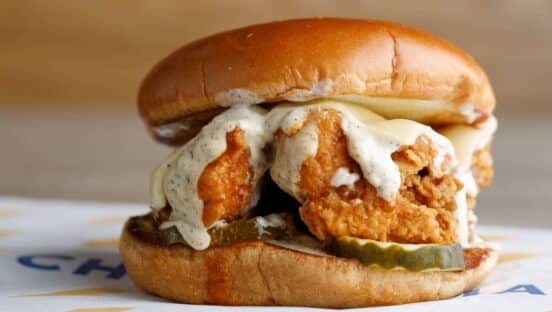The military may not immediately come to mind as a go-to foodservice resource, but closer inspection suggests some eye-opening and revealing connections. QSR recently had the privilege of touring the galley of the USS Jefferson City, a Navy submarine home-ported in San Diego. This innovative foodservice operation, with its limited space and high volume, is a tightly run ship. Lest these words have lost their visual punch, a few minutes aboard this vessel will spiffy them right up.
The entry is down a ladder that drops 20 feet into the hull of bustling activity. Roughly 130 men are working aboard this 360-foot-long, 33-foot-wide ship, and each is on task. Some huddle over a workspace while many are on the go, in and out of doorways and around passages, standing tall to one side to let someone pass. The crew moves quickly and on a schedule they dutifully respect. A military submarine commands efficiency.
There are no exceptions, least of all the galley, which operates around the clock to stay on top of its game. A team of six feeds the entire crew. That’s four high-volume meals this team cranks out in 18 hours every day. And only two do the cooking, one during the day and one at night. Standing in the galley it’s clear why. About 10 feet by 14 feet, this small space (even by a quick serve’s standards), boasts nothing high tech or fancy save the pristine military shine on floor-to-ceiling stainless steel.
Two convection ovens side by side, a microwave oven, one deep fryer, twin cavernous soup pots, and an industrial-sized mixer are the only equipment. A tiny sink, sanitizer, cabinets, and drawers fill out any remaining space. Dog-eared recipe cards perched at eye level are in quick reach of the generous assortment of bulk spices.
It’s all about the basics here. Just try to squeeze in anything else.
Sure, space and time are limited, but service can’t be. In these close confines, there’s simply no room for compromise. Led by Lt. j.g Jason Thomas and culinary specialist chief (CSC) Brandon Ramos, the USS Jefferson City galley team doesn’t focus on limitations.
Whatever luxuries the galley lacks, this team makes up for in productivity and style. Their sights are on flavor and the morale of the crew. “It’s paramount the food be right every time,” Thomas says. “My team has to get it right. We’re only limited by provisions.”
On a sub, the amount of food stowed is capped by space. So provisions are limited, but only as limiting as the galley team allows. Buying in bulk not only means the Jefferson City can store more ingredients; it also means most of its meals are prepared completely from scratch. In fact, this galley team bakes fresh bread every day.
“We’re notorious for that,” Ramos says with a smile. This is one of many ways they enhance their menu repertoire. The Navy supplies a variety of recipe cards, but for this crew, they’re purely guidelines. Their creative energy goes toward improving the flavor of an otherwise ordinary dish as they experiment, gauge results, and come back again and again to make it better. They especially love to “change it up,” as Ramos says, by adding a new spice or “beefing up” the barbecue sauce with one of at least eight hot sauces the galley stocks.
“Our guys want change constantly,” he says. It takes a lot of planning and each chef has developed his own signature spin.
“We’re always improving, we’re motivated by that,” says Ramos, who expects continued progress. “This is my artwork,” he says. “All the guys are like that.”
It’s visible in this team. There is complete buy-in, and the men thrive on it. Thomas and Ramos can’t say enough about their team and how good they are individually.
“This is the best group in 16 years,” Ramos says. It’s this selfless mindset that makes this group work so well together. The fact that every one of them is trained in every job no doubt keeps them grounded and on the same page, but it also contributes to the strength and cohesion of this galley.
Like most chefs, they do have their specialties (and their weaknesses). Ramos admits baking isn’t his forte, but he could do it as they all could. This team’s leaders are not so far removed that they don’t remember what it was like to be in a different place.
“I was them five years ago,” he says. Ramos and Thomas make it a point to relate to their guys, joking, telling stories, and most of all having fun at work. Thomas sums it up well when he says, “I want them working for me because they want to, not because they have to.”
Leading by example is part of what makes this a cohesive, smooth-running team. Ramos attended culinary school before he joined the Navy and even trained at the Culinary Institute of America (CIA) as part of a culinary award he earned on another ship.
Here, the training is hands-on. Thomas and Ramos are side by side with their crew, showing them how it’s done and coaching them along. “It took a year’s training for this group to fully come around,” Ramos says, “and now they’re top-notch chefs.” This is a team that works as one, from the top right on down. This is the way it should be, Ramos says.
“The boss should be in there doing the job and getting the respect of the guys.” It’s that mutual respect that feeds the camaraderie these men share. They enjoy their job and take their responsibilities seriously, but are quick to tell you they are not serious on the job by any means. “We burn thousands of calories laughing,” Ramos says. It’s all in a day’s work in this galley.
[pagebreak]
Submarines are often under way, or at sea, for weeks if not months at a time, which calls for creative overtime in the kitchen. The ship is bursting with provisions when it’s first deployed, but they dwindle quickly, especially the fresh fare that lasts an all-too-brief 10 days. This is when the fun begins as the men dig deep for any and every new take and twist they can to give their crew variety and different flavors.
“Flavor and morale are the issue,” Thomas says. “If they’re happy, we’re happy.” They follow Navy guidelines for a three-week menu cycle so ingredients like fresh meat and poultry, starches, and vegetables rotate, but they add further variety by, say, breading the chicken one night and grilling it another. They also like to surprise the crew with something that’s not on the menu, like their oatmeal cookie pie and taco bowls.
“They love it,” Ramos says. “We do several very creative tactics to maintain happiness.” They crafted the mold for the taco bowls, made with flour tortillas, using a round cylinder plate with a handle they submerge in the fryer.
They are serious about getting the food right and their efforts don’t go unnoticed. The comment board, which hangs prominently just within the entry to the crew mess hall, displays comment cards where crew members and galley visitors post praises for the galley’s culinary excellence. The multitude of cards vying for space is how word gets outside the sub to attract the frequent attention this galley has come to expect.
It has been nominated as one of the best submarine galleys in the Navy and has competed against and placed in the top four among more than 100 subs. It also won a Blue E (for excellence) award in its squadron of six submarines. This recognition is hugely significant for the USS Jefferson City, for its galley team, and for each team member. It’s a big accomplishment that builds camaraderie and stokes motivation.
Foodservice professionals of all sorts understand that food does more than satisfy hunger, and they strive to maximize those pulse points for their customers. A pleasant and comfortable atmosphere and good company, as well as flavorful food, enhance the experience of a meal. This is even more pronounced for a submarine crew whose work, which is among the most difficult in the Navy, takes them away from home and family for long periods of time.
Meals represent a break, a time to socialize and laugh, and a time to treat the senses to a meal made from scratch that reminds them of home. It’s no surprise that their meals are often the highlight of the day. Crew members stop Ramos all the time to tell him how much they look forward to what’s on the menu.
The galley team strives to make the experience live up to expectations on all levels. The crew mess is close quarters but lively and pleasant with bright orange picnic-style tables and padded benches to seat 24 (meals are served in shifts), wall décor, a food line, salad bar, coffee station, and ice cream station. Tables are spruced up with cheery vinyl cloths and caddies stocked with sauces and condiments. It’s pleasant, it’s clean, and it’s perhaps the place they most look forward to in their day.
Precise planning and organization are critical before the Jefferson City goes to sea. A six-month deployment demands an initial food load out of about $150,000, plus five replenishments from ports along the way at about $110,000. That first load-out process when the food is stowed securely or tied down for sea takes three weeks of full-time efforts.
“We want to maximize that time and space. We depend on it,” Thomas says.
The ship’s walk-in freezer and adjacent walk-in chill box, which can be converted to a freezer at the beginning of a deployment, are packed with no inch to spare. Dry storage with rows of packaged goods stacked tightly from floor to ceiling is heavily utilized as well.
The food on the table is always center stage and this team doesn’t disappoint. Ramos works by the mantra he rattles off militaristically: “Food is about appearance, taste, texture, and color. You eat with your eyes.”
He makes sure every dish is garnished and presents well. This team even pays attention to color in the planning stage of each menu with the end result in mind.
“We go beyond the norm,” Ramos says. The orange chicken, for example, is made from scratch, which they’re not supposed to do, so the glaze has that appealing shimmer. It’s then garnished with a sprinkling of sesame seeds and fresh green onions.
Attention to this kind of detail is an especially tall order when cooking for a crew of 130 who eat “double of everything,” Ramos says. “That’s 200 portions for 100 people.”
It simply cannot be done without astute attention to planning and organization. “We pride ourselves on being clean and organized,” Ramos says.
“We keep it up on a day-to-day basis. These guys are accountable. They know if they don’t make the effort, the others suffer. We’ve never run short, we’ve never had to portion control. We don’t waste either. They do a phenomenal job.”
Operating consistently at such high efficiency and productivity comes down to this galley team’s attention to every detail involved in fueling the USS Jefferson City.
This group of six takes foodservice to its fundamentals and proves it can be successful in conditions other kitchens would deem inadequate. Their collective drive to look ahead and always improve shatters basic expectations.











